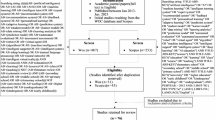Abstract
China started nanotechnology research from 1990s, and has paid much attention to nanoeducation since then. Scientific discoveries from nanoresearch have been introduced timely into high school textbooks, and more specific courses such as Nanomaterials and Nanofabrication are being taught at both college and graduate levels. In this paper, nanotechnology courses at the Graduate University of Chinese Academy of Sciences, Beijing University, and Tsinghua University are chosen to be overviewed, which could be a good indicator of Chinese nanoeducation because of high-quality science and engineering education in these schools. Research institutes also contribute in popularizing nanoscience knowledge through activities such as public open days. These combined efforts substantially promote the public acceptance and understanding of nanoscience and technology in China.

Similar content being viewed by others
References
Butt NM, Yaldram Kh (2010) Need for nanotechnology education for specific undergraduate (BS) degrees. In: Proceedings of the international conference on nanotechnology: fundamentals and applications, Ottawa, ON, Canada, 4–6 Aug 2010 (Paper number 264)
CAS (2011) Chinese nanotechnology roadmap to 2050. Science Press, Beijing
Malsch I (2008) Nano-education from a European perspective. J Phys Conf Ser 100:032001
Mehta BR (2009) Nano education at Indian Institutes of Technology: a status report. J Nano Educ 1:106–108
MEXT Japan (2010) White Paper on Science and Technology 2010. http://www.mext.go.jp/english/whitepaper/1302537.htm. Accessed 2 April 2014
MOST (2011) Statistical data. http://www.sts.org.cn/sjkl/kjtjdt/index.htm. Accessed 2 April 2014
MOST, MOE, CAS, NSFC (2001) National Programme of Nanotechnology Development (2001–2010). http://www.most.gov.cn/fggw/zfwj/zfwj2001/200512/t20051214_55037.htm. Accessed 2 April 2014
Roco M, Bainbridge W (2003) Converging technologies for improving human performance: nanotechnology, biotechnology, information technology and cognitive science. Kluwer Academic Publishers, Dordrecht
Sargent JF Jr (2010) Nanotechnology: a policy primer. In: CRS report for congress, 12 March 2010. http://www.fas.org/sgp/crs/misc/RL34511.pdf. Accessed 2 April 2014
Wan Y, Pan Z (2010) Engineering education on nanotechnology for undergraduate students. High Educ Chem Eng 6:12–15
Wang ZL (2002) On research and education scheme for training nanoscientists. China Basic Sci 4:29–33
Acknowledgments
The authors are grateful to Professor Zhu Xing of Beijing University, Professor Gao Celi of Tsinghua University, and Ms. Pan Hailian of NCNST for their help in providing nanotechnology curriculum information. This work is supported by the Knowledge Innovation Program of the Chinese Academy of Sciences (Grant No. KJCX2-EW-M04).
Author information
Authors and Affiliations
Corresponding author
Rights and permissions
About this article
Cite this article
Wu, S., Guo, Y., Yang, Y. et al. Nanoeducation in China: current status. J Nanopart Res 16, 2380 (2014). https://doi.org/10.1007/s11051-014-2380-8
Received:
Accepted:
Published:
DOI: https://doi.org/10.1007/s11051-014-2380-8




